William Joyce, “Lord Haw-Haw”
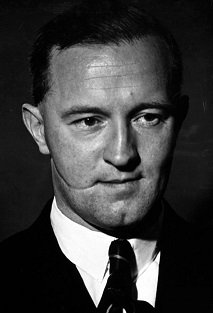 William Joyce was born in Brooklyn in 1906, the child of two immigrants. Joyce’s father Michael was a Catholic and a native of Mayo, while his mother Gertrude was English and an Anglican. This cultural difference was why Joyce wound up without a middle name – his mother wished to follow the occasional English tradition and use her maiden name of Brooke as his middle name, while Michael’s people believed that the second name should be that of a saint, preferably one of some significance to their parents. They compromised by baptising him (in the Anglican faith) without a middle name, though he may have used Brooke on occasion later in life when he wished to emphasise his Englishness. In fact, his father had become a naturalised American citizen in 1894, and so young William was a first-generation American. Michael was a builder and a landlord, and by all accounts a relatively successful one. In 1909 he decided that he wanted his son to be raised in Ireland, and so he returned to open a pub in Galway with the money he had made in America. Unfortunately he returned to an Ireland where civil unrest hovered on the edge of open revolt, and where his Catholic religion and staunch support for the British crown won him no friends in either camp. Joyce inherited his father’s loyalty, though not his religion.
William Joyce was born in Brooklyn in 1906, the child of two immigrants. Joyce’s father Michael was a Catholic and a native of Mayo, while his mother Gertrude was English and an Anglican. This cultural difference was why Joyce wound up without a middle name – his mother wished to follow the occasional English tradition and use her maiden name of Brooke as his middle name, while Michael’s people believed that the second name should be that of a saint, preferably one of some significance to their parents. They compromised by baptising him (in the Anglican faith) without a middle name, though he may have used Brooke on occasion later in life when he wished to emphasise his Englishness. In fact, his father had become a naturalised American citizen in 1894, and so young William was a first-generation American. Michael was a builder and a landlord, and by all accounts a relatively successful one. In 1909 he decided that he wanted his son to be raised in Ireland, and so he returned to open a pub in Galway with the money he had made in America. Unfortunately he returned to an Ireland where civil unrest hovered on the edge of open revolt, and where his Catholic religion and staunch support for the British crown won him no friends in either camp. Joyce inherited his father’s loyalty, though not his religion.

Joyce was educated at a Catholic school, where he gained notoriety as a bully and organiser of gangs. He broke his nose in a fistfight, but kept this a secret from the teachers. As a result his nose was not set correctly, and the misaligned bones gave a pronounced nasal tone to his voice for the rest of his life. It was his Jesuit schooling, ironically, that undid his religion. The monks taught him that as a Protestant his mother was condemned to hell, which Joyce refused to believe. In some ways the whole country seemed to be going to hell, as Joyce himself later told stories of seeing a Sinn Fein supporter gunned down by police, and of finding a policeman who was a friend of his father shot dead in the street. The Galway RIC barracks, leased from his father, were destroyed in an IRA attack in 1920, and later that year Joyce became an informer to the British Auxiliaries. He was not as discreet as he should have been, and later claimed to have been the target of an attempted assassination attempt as he made his way home one day. This may be why in December 1921, when the Anglo-Irish treaty made Galway part of the new Irish state, the Joyces left for Lancashire.
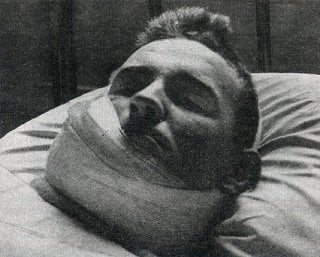
Once in England Joyce enlisted in the Worcestershire Regiment of the British Army, though he was still several months shy of the minimum recruitment age of 16. He did this by claiming to not have a birth certificate (common enough in those days), and got away with this ruse for a while. Eventually however he was found out and discharged. He had enjoyed his brief taste of military life, and decided to try to become an officer via the Officer Training Corp at London University. After passing the entrance exam he first studied at Battersea Polytechnic, and then at Birkbeck College. This was when he became interested in politics, and he was the President of the Conservative Society there. His politics tended towards the extreme right wing, and he got involved with a society called the British Fascisti. Despite the name it was not a Fascist group in the traditional sense – rather, it was an anti-Communist group, mostly composed of Conservative supporters. Through it Joyce made his first contacts in genuine fascism, as well as making the acquaintance of Maxwell Knight. Knight was a secret MI5 agent who had joined the group in order to monitor it for seditious behaviour. He would later go on to become the chief officer in charge of MI5’s network of agents within such groups, and Joyce was one such agent. [1] He didn’t provide Knight with information on his own groups,, however, but rather on what they learned about the activities of their enemies. Joyce also took a less welcome souvenir from his time in the BF. The group often volunteered as stewards for potentially contentious Conservative events. When one such event devolved into a brawl with members of the British Communist Party, Joyce received a razor cut from the corner of his mouth to behind his ear that left a deep scar he would carry for the rest of his life. Though he blamed the wound on “Jewish Communists”, in fact he had no idea who cut him, or that he’d even been cut until he saw the reaction of those around him.
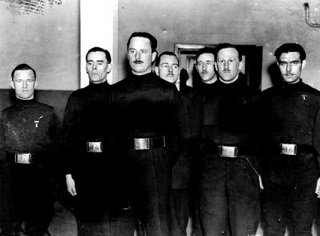
Joyce’s antisemitism also surfaced in the reason he gave for failing to complete his MA. He blamed it on a “female Jewish tutor” [2], though his own lack of interest in the hard work of research for the degree was more likely to blame. Instead he took a job at the Victoria Tutorial College, and shortly before his 21st birthday in 1927 he was married to Hazel Barr, with whom he would have two daughters. He remained active in the Conservative Party, but his embitterment at failure to get a job in the Foreign Office along with his more and more outspoken antisemitism led to him leaving in 1930. He had kept in contact with his old BF contacts, and so in 1932 he was one of those who was reached out to when Oswald Mosley, an opportunistic politician who had burned his bridges in both the Conservative and Labour parties, was forming the British Union of Fascists. Unlike the BF, Mosley intended the BUF to be a fully Fascist organisation, with himself as leader. The Blackshirts, as they became known, were supported by several national newspapers (including the Daily Mail), and most of the unaffiliated rightwingers in England soon joined their ranks. Joyce was an enthusiastic convert, and he soon revealed an untapped talent for passionate public speaking.

The BUF enjoyed a lot of good publicity for its first two years, but in 1934 it fell into disrepute. A rally in Olympia was infiltrated by around 500 anti-fascists (including Aldous Huxley), and the vicious treatment they received from the BUF stewards (which resulted in some who had originally come to support the BUF instead fighting to defend the protesters) turned public opinion sharply against Mosley. He responded by firing his Director of Propaganda and replacing him with Joyce. This allowed Joyce to directly influence the party’s policies, and they rapidly turned more and more antisemitic. The party began organising attacks on Jewish districts of London, culminating in the famous Battle of Cable Street, where a BUF march through the East End was blocked by local people organised under left-wing organisations. Faced with open faction warfare in the streets, the government passed the Public Order Act of 1936, which banned political paramilitary organisations and the wearing of political uniforms. This severely curtailed the operations of the BUF, though it did help them improve their relationship with the police. Meanwhile Joyce began an affair with Margaret White, a Scottish member of the BUF, and in 1937 he divorced his first wife and married her. The same year he stood for Parliament under the BUF banner, and though he knew he had no chance in the constituency he had been assigned (due to being politically outmanoeuvred within the party), he did manage to record far more votes than had been expected. The general election was a disaster for the BUF though, and Mosley decided to trim back the party’s leadership. Joyce, who had become more and more outspoken in his contempt for “the Leader” (who he privately referred to as “the Bleeder”), was unsurprisingly one of those eliminated.
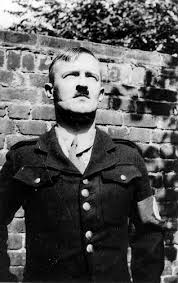
Set loose to his own devices, Joyce drifted even further to the right. Along with two other ex-BUF leaders he founded the National Socialist League on the twin platforms of antisemitism and demanding a formal pact with Hitler. The public mood was strongly against this however, and the shadows of war were clear on the horizon. He had already sounded out the Germans and been assured of a welcome there when in 1939 he was tipped off by his old friend Maxwell Knight that a sweep of the British Fascist organisations was planned, and that he was already marked for arrest. He and his wife fled the country, four days before Special Branch detectives turned up on his doorstep.
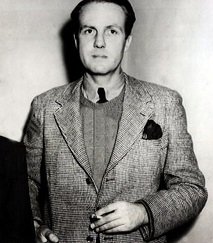
Joyce had already made contact with the German propaganda minister Joseph Goebbels, and he was quickly pressed into service on the German radio broadcasts. Though his initial tests were unpromising due to a combination of inexperience and a cold, his talent was soon recognised. His first role was as “The Professor”, a nickname from his early days in the BUF based on his university education, but he soon took over the role of “Lord Haw-Haw”. The original Haw-Haw was Norman Baillie-Stewart, a former British officer who had been cashiered and imprisoned for trying to sell secrets to the Germans. The nickname was given to him by the British press, but it was Joyce who was the first to be named as such on air. The fiction of the “New British Broadcasting Station”, as it was called, was that it was being broadcast from within the UK by dissident citizens. Since Joyce was a known fugitive, he didn’t partake in this fiction but instead admitted to being based in Berlin, which he did in 1941 in response to a newspaper article claiming he was running a spy ring in London.
I, William Joyce, will merely say that I left England because I would not fight for Jewry against the Führer and National Socialism, and because I believe most ardently, as I do today, that victory and a perpetuation of the old system would be an incomparably greater evil for [England] than defeat coupled with a possibility of building something new, something really national, something truly socialist.
The broadcasts made Joyce one of the most hated men in England, almost more than Hitler himself. Rumors spread of his supposed omniscience, with him commenting on the condition of village clocks as a sign of the detailed level of knowledge he had. This legend even inspired one of the wartime Sherlock Holmes films starring Basil Rathbone – the Voice of Terror. As a result of his success Joyce was feted in Berlin, but also placed under a heavy workload of broadcasting and writing. His resulting neglect of his wife Margaret led to their divorce in 1941. Joyce was eventually placed in charge of all propaganda broadcasts to Britain, a choice which may have actually reduced their effectiveness. Joyce was good on a soapbox, but lacked subtlety. Still, he found his niche in the Nazi war machine, even writing a book to be given to British prisoners of war, and was comfortable enough. Until the Nazis lost the war, of course.
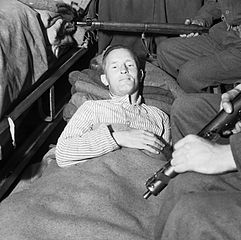
Joyce’s last broadcast was a messy drunken affair, and he fled his studio just ahead of the oncoming British forces. On 4th May 1945 the victorious British used Joyce’s equipment to make a broadcast mocking his “Germany calling” callsign and declaring a takeover by the BBC. Joyce fled north to the Danish border, but on the 28th of May he was recognised by a British patrol. He tried to convince them of his identity, but a jumpy soldier shot him in the buttocks and he was captured.
Joyce was taken to London, and tried in the Old Bailey on a charge of high treason. The charge was only valid if he was a British citizen at the time of his broadcasts, and so it was his early work as “the Professor”, before he renounced his citizenship, that he was tried for. His defence was that as he was born an American citizen his British citizenship was legally invalid. While this was true, the judge decided that by claiming a British passport he had made his allegiance to the crown, and as such the charge of treason was valid. He went to the gallows defiant, declaring his belief that the Swastika would “be raised from the dust” once again. As was traditional for traitors he was buried in an unmarked prison grave. His daughter Heather (by his first wife) began campaigning in the 1960s for his remains to be reburied, and in 1976 he was exhumed and shipped to Galway. There, a faded headstone marks the final resting place of the infamous Lord Haw-Haw.
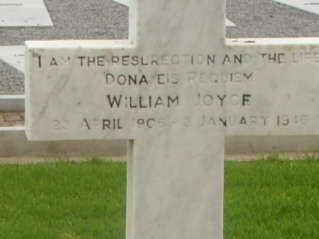
Images via Nickel In The Machine except where stated. Some of Joyce’s broadcasts have been digitised and are available at Earthstation1.com.
[1] Knight was one of the MI5 officers that Ian Fleming drew on in creating the character of M, and James Bond’s master may owe his initial to Knight’s first name.
[2] Though his tutor was female, she wasn’t actually Jewish.
